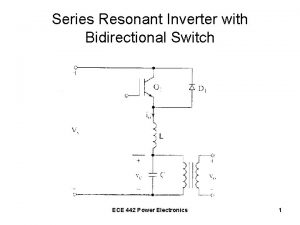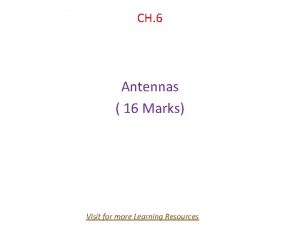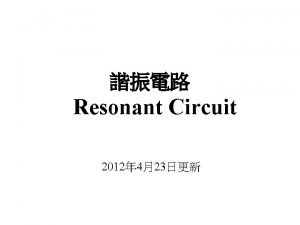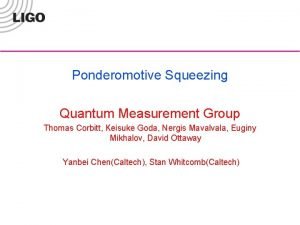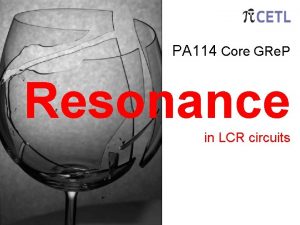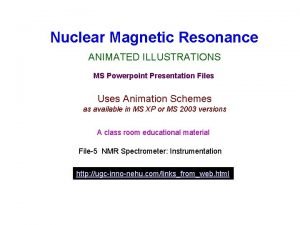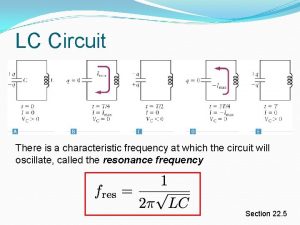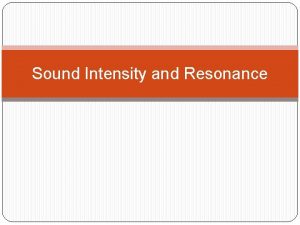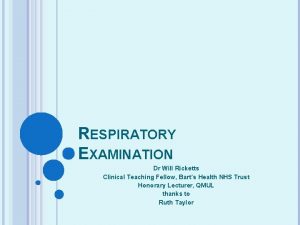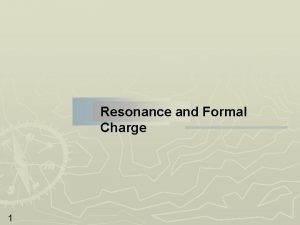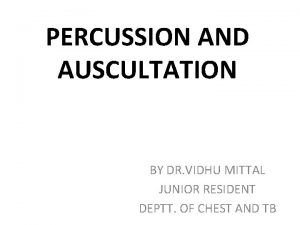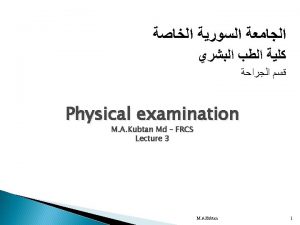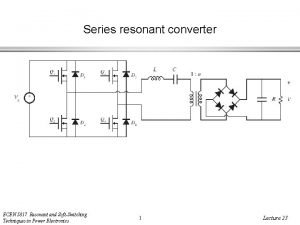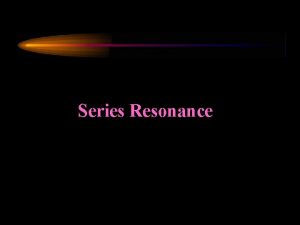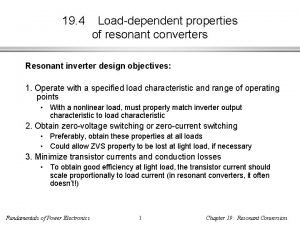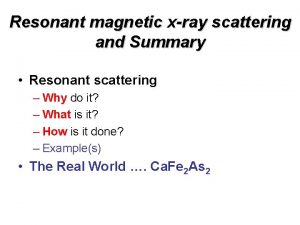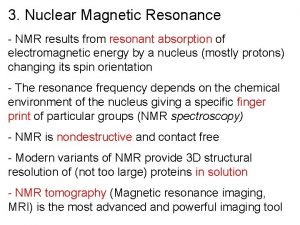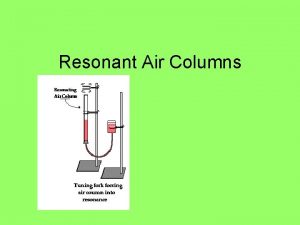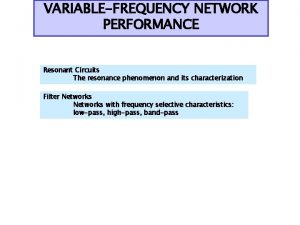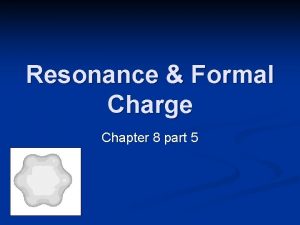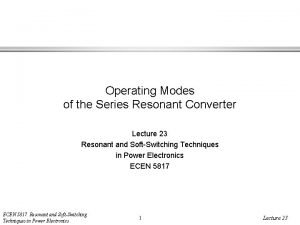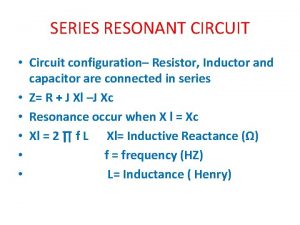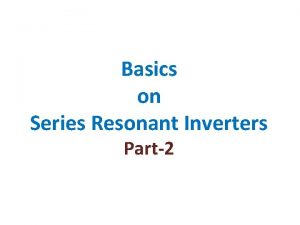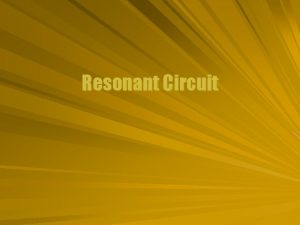Chapter 21 Resonance Series Resonance Simple series resonant






























- Slides: 30

Chapter 21 Resonance

Series Resonance • Simple series resonant circuit – Has an ac source, an inductor, a capacitor, and possibly a resistor • ZT = R + j. XL – j. XC = R + j(XL – XC) – Resonance occurs when XL = XC – At resonance, ZT = R 2

Series Resonance • Response curves for a series resonant circuit 3

Series Resonance 4

Series Resonance • Since XL = 2 f. L and XC = 1/2 f. C for resonance set XL = XC – Solve for the series resonant frequency fs 5

Series Resonance • At resonance – Impedance of a series resonant circuit is small and the current is large • I = E/ZT = E/R 6

Series Resonance • At resonance VR = IR VL = IXL VC = IXC 7

Series Resonance • At resonance, average power is P = I 2 R • Reactive powers dissipated by inductor and capacitor are I 2 X • Reactive powers are equal and opposite at resonance 8

The Quality Factor, Q • Q = reactive power/average power – Q may be expressed in terms of inductor or capacitor • For an inductor, Qcoil= XL/Rcoil 9

The Quality Factor, Q • Q is often greater than 1 – Voltages across inductors and capacitors can be larger than source voltage 10

The Quality Factor, Q • This is true even though the sum of the two voltages algebraically is zero 11

Impedance of a Series Resonant Circuit • Impedance of a series resonant circuit varies with frequency 12

Bandwidth • Bandwidth of a circuit – Difference between frequencies at which circuit delivers half of the maximum power • Frequencies, f 1 and f 2 – Half-power frequencies or the cutoff frequencies 13

Bandwidth • A circuit with a narrow bandwidth – High selectivity • If the bandwidth is wide – Low selectivity 14

Bandwidth • Cutoff frequencies – Found by evaluating frequencies at which the power dissipated by the circuit is half of the maximum power 15

Bandwidth 16

Bandwidth • From BW = f 2 - f 1 • BW = R/L • When expression is multiplied by on top and bottom – BW = s/Q (rad/sec) or BW = fs/Q (Hz) 17

Series-to-Parallel Conversion • For analysis of parallel resonant circuits – Necessary to convert a series inductor and its resistance to a parallel equivalent circuit 18

Series-to-Parallel Conversion • If Q of a circuit is greater than or equal to 10 – Approximations may be made • Resistance of parallel network is approximately Q 2 larger than resistance of series network – R P Q 2 R S – XLP XLS 19

Parallel Resonance • Parallel resonant circuit – Has XC and equivalents of inductive reactance and its series resistor, XLP and RS • At resonance – XC = XLP 20

Parallel Resonance • Two reactances cancel each other at resonance – Cause an open circuit for that portion • ZT = RP at resonance 21

Parallel Resonance • Response curves for a parallel resonant circuit 22

Parallel Resonance • From XC = XLP – Resonant frequency is found to be 23

Parallel Resonance • If (L/C) >> R – Term under the radical is approximately equal to 1 • If (L/C) 100 R – Resonant frequency becomes 24

Parallel Resonance • Because reactances cancel – Voltage is V = IR • Impedance is maximum at resonance – Q = R/XC • If resistance of coil is the only resistance present – Circuit Q will be that of the inductor 25

Parallel Resonance • Circuit currents are 26

Parallel Resonance • Magnitudes of currents through the inductor and capacitor – May be much larger than the current source 27

Bandwidth • Cutoff frequencies are 28

Bandwidth • BW = 2 - 1 = 1/RC • If Q 10 – Selectivity curve becomes symmetrical around P 29

Bandwidth • Equation of bandwidth becomes • Same for both series and parallel circuits 30
 Series resonant inverter with bidirectional switches
Series resonant inverter with bidirectional switches Non resonant antenna
Non resonant antenna Rlc q factor
Rlc q factor Fluid valve
Fluid valve Kyle corbitt
Kyle corbitt Resonant frequency formula
Resonant frequency formula Resonant inductive coupling ppt
Resonant inductive coupling ppt Resonant frequency formula
Resonant frequency formula Et 242
Et 242 Simple present, simple past, simple future
Simple present, simple past, simple future Simple past simple present simple future
Simple past simple present simple future Simple past simple present simple future
Simple past simple present simple future Past simple future
Past simple future Simple present simple future
Simple present simple future Present simple present continuous past simple future simple
Present simple present continuous past simple future simple Present and past tense
Present and past tense Simple present
Simple present Present simple past simple future simple
Present simple past simple future simple Maclaurin series vs taylor series
Maclaurin series vs taylor series Heisenberg 1925 paper
Heisenberg 1925 paper Taylor vs maclaurin
Taylor vs maclaurin Deret maclaurin
Deret maclaurin Ibm p series vs i series
Ibm p series vs i series Shunt series feedback amplifier
Shunt series feedback amplifier Series aiding and series opposing
Series aiding and series opposing Arithmetic sequence sum formula
Arithmetic sequence sum formula Sound intensity and resonance
Sound intensity and resonance Lymph node palpation order
Lymph node palpation order Resonance and formal charge
Resonance and formal charge Types of lung sounds
Types of lung sounds Resonance vs dullness
Resonance vs dullness
